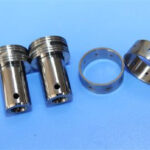Two common wire drawing die processing methods
At present, the more common wire drawing dies on the market are diamond drawing dies and cemented carbide drawing dies. Below we introduce the processing methods of these two drawing dies to let everyone have a deeper understanding of these two products.
One, the processing method of diamond wire drawing mould tool
There are two methods for diamond molds as follows.
The first method
After grinding the two supporting surfaces and the observation surface of the diamond, the processing of each process is carried out. Its advantage is that the transparency of the diamond can be used to observe the processing processes such as open holes. Its disadvantage is that part of the diamond must be ground off; the diamond is small and it is inconvenient to fix it during processing. Use this method when processing small diameter mold holes.
The second method
After sintering the diamond and related powders into a block and inserting a sleeve, the processing of each process is carried out. The disadvantage of this method is that it cannot directly observe the machining process of the mold hole. Its advantage is that 2/3~4/5 of the diamond is less than the previous method. It is easy to determine the center, and it is convenient to process and operate the mold. It is often used for processing large diameters. Diamond mold hole. When diamond molds are used for drawing, when stripes are formed on the surface of the mold hole, metal is stuck, the mold hole is worn out and the diameter of the sizing belt increases, and other defects, it needs to be re-grinded and reused after increasing the diameter of the mold hole. Re-grinding can be performed many times until cracks occur in the diamond.
Processing method of cemented carbide wire drawing die
mainly uses mechanical grinding processing method, the process is as follows:
Select blank → insert sleeve → work cone polishing → lubrication cone polishing → exit cone (zone) polishing → sizing belt polishing → transition zone polishing → working cone polishing → sizing belt polishing → inspection and acceptance.
In addition, there are chemical-mechanical grinding processing methods, ultrasonic processing methods, electro-fire processing methods, and electrolyte processing methods. In the process of drawing, the hole of the cemented carbide die has groove marks, oval shape, and metal adhesion on the surface due to wear. It needs to be re-grinded, and the diameter of the die hole is enlarged to the size of the adjacent die hole to continue to use. Re-grinding can be performed multiple times until the mold wall is reduced to cause cracks.
Three, the selection of wire drawing die material and its application characteristics
Diamond and cemented carbide are the main materials for wire drawing die processing. The application of the two materials is quite different and each has its own characteristics.
Diamond is the mold material with the highest hardness, excellent wear resistance, brittle quality and expensive mold among the known substances. This kind of wire drawing dies are difficult to process. Generally, powder metallurgy dies with a wire diameter of less than 1.0mrn are made. At present, the diameter of the largest diamond die has reached 2.5mrn.
Cemented carbide adopts tungsten-cobalt cemented carbide, which is composed of tungsten carbide and cobalt. Tungsten carbide is hard and wear-resistant as the “framework” of the alloy, and cobalt is the bonding metal, which increases the toughness of the alloy. As the cobalt content increases, the density, hardness, compressive strength, number of elastic molds, thermal conductivity and resistivity of the alloy decrease, while the toughness and flexural strength increase. As the content of tungsten carbide increases, the performance of the alloy is just the opposite of the above-mentioned increase in cobalt content. Cemented carbide has good properties of high wear resistance, corrosion resistance and alkali resistance, anti-emulsion and other lubricating materials. Cemented carbide wire drawing dies are widely used in the drawing production of various metals and alloy wires.
Other mold materials steel is made of wire drawing molds with low cost, convenient processing and repair, but it has low hardness, poor wear resistance, and short service life. After the 1970s, it has actually been used as mold materials such as cemented carbide and diamond. Replaced. The hardness and wear resistance of synthetic diamond is second only to natural diamond and better than cemented carbide, and the price is significantly lower than natural diamond. It is a good material for making wire drawing dies. The polycrystalline wire drawing die made of synthetic diamond has been used in the production of rough drawing and middle drawing copper wire and steel wire.
Link to this article:Two common wire drawing die processing methods
Reprint Statement: If there are no special instructions, all articles on this site are original. Please indicate the source for reprinting:Tungusten,Thanks!^^




